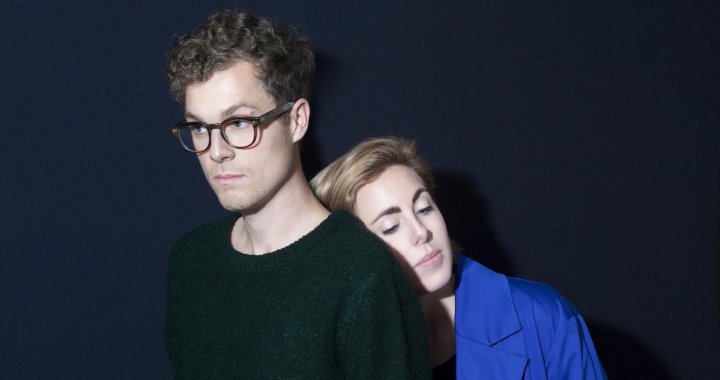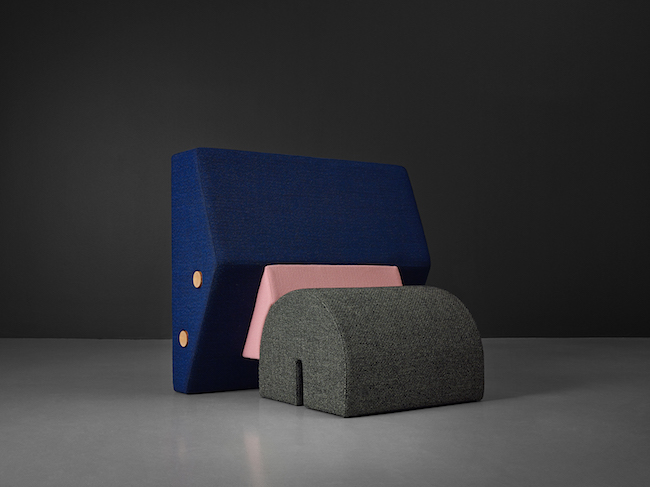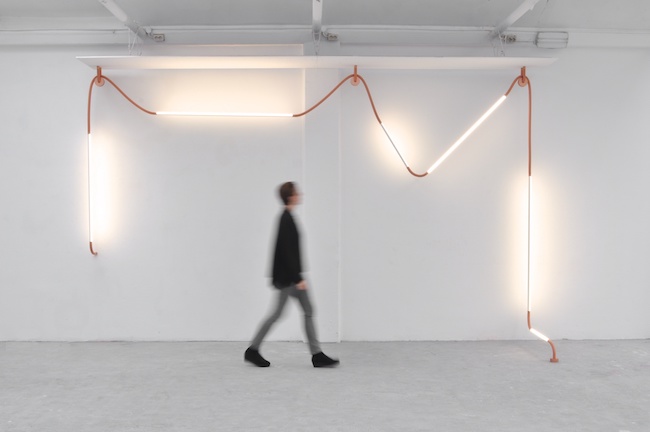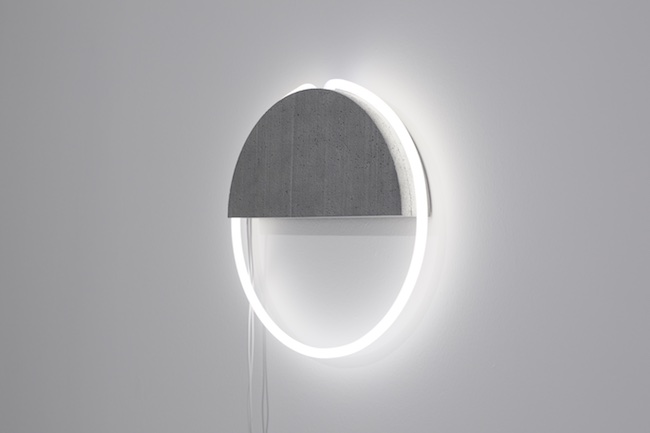
Surviving being thrown out into the open
An interview with Dutch designers Oskar Peet and Sophie Mensen from os ∆ oos studio
31/10/2017
The Keystone chair is composed of three unjoined parts. It is held together by gravity and the weight of each part. The chair’s backrest is made of concrete, the middle part is made of rubber, but the seat itself is an arc of heavy ceramic. Keystone’s visual presentation is not dictated by plays on form and lines, but through experimentation with materials whose weight creates a functional piece of furniture. The LED lamp Mono-Lights is constructed of connecting tubes made of silicon composite material; this allows the lamp to be bended into various configurations as it becomes more of a sculptural object than a utilitarian lamp.
These are two examples of products created by the Dutch designer duo known as os ∆ oos – Oskar Peet from Canada and Sophie Mensen from the Netherlands, both graduates of Design Academy Eindhoven. They like to position os ∆ oos as a design studio for contemporary objects rather than a furniture design company. In the summer of 2017, Peet and Mensen were lecturers and workshop instructors at the MAD International Summer School of Design in Sigulda, Latvia. The following conversation with the designers took place on a summer evening at Krimulda Manor.

Peet: Latvia surprised me. I didn’t expect that I would like it as much as I do. I’m surprised that everything here is so well organized. Everywhere the grass is mowed and it’s so quiet. Living in the Netherlands, we’re used to people living much more compactly. I don’t know what it would be like to work as a designer here because there are so few people and there definitely are problems with the infrastructure. But I grew up in Canada, which is also not a densely populated country. In a sense, in Latvia I feel much like in Canada. People focus more on life’s basic needs in countries like these. That’s not bad, because everything is simpler. I’m surprised how well the students and craftsmen speak English here. In Italy or Spain, for instance, it would be practically impossible to speak with the local craftsmen in English.
How did you come to Eindhoven from Canada?
P: In Canada I studied engineering, and at first I though I would continue my studies in engineering in the Netherlands; but then I decided to switch my studies to design. Nevertheless, the knowledge of how things work, how they are constructed, is very useful in my work as a designer.
Mensen: Especially since constructions are not my strong side.
After graduating from the Design Academy Eindhoven, you founded os ∆ oos and decided to stay in Eindhoven…
M: This decision was basically made by the city itself, its environment of design and entrepreneurship. We’re used to the fact that in Eindhoven everything is “right around the corner” – producers, other designers and entrepreneurs – which is why it’s easier to realize your ideas and receive consulting, suggestions, and help. We rent a studio space together with two other design offices.
P: In Eindhoven both the cost of living and the cost of producing are somehow lower. It’s possible to realize many things here cheaper than in London or some other world metropolis. The cost of running a new and small design studio is an important factor.
Eindhoven is swiftly changing. Not too long ago the former Philips factory building, which stands in the center of the city, was in ruins. Well, it wasn’t exactly in ruins, but it had stood empty for years. Back then it was a “no-go” area with a high fence around the factory park.
M: When we went to school we held secret parties there.
P: And now the Philips factory park has changed beyond recognition. It was the first place in Eindhoven that was specially earmarked for cultural interests. The Philips park quickly developed, and now it’s the most fashionable place in the city – it was the first place with 3D printers and stylish cafés and ice-cream shops. It’s become the city’s creative center. This creative and fashionable “bug” is somehow spreading throughout the city. For the first time ever, Eindhoven is becoming a stylish and fashionable city. Eindhoven has always been linked to design and production, but it was never seen as a fashionable place to live. Now the situation has changed, and it’s becoming increasingly more pleasant to live there...and even harder to leave it.
M: We’ve thought about moving somewhere else, but there have never been enough good reasons to do it, so we’ve stayed in Eindhoven.
P: Why leave Eindhoven if life is becoming increasingly better? We know many designers who moved to Amsterdam or London but have now moved back to Eindhoven.

Have you also retained a connection to Design Academy Eindhoven?
M: We don’t have a direct link to the Academy, but mentally we still feel really close and we follow along with what’s happening at the school, how it’s evolving. Of course, Design Academy Eindhoven has made this a design city and enforces this image. Wherever we go, and we do travel a lot, everyone has heard of Eindhoven and associates it with design.
P: In any case, we don’t have to be ashamed of where we come from. There have been big changes going on at Design Academy Eindhoven lately, however. I even have a hard time imagining what the Academy is like now because many of the school’s staff and teachers, who worked there for decades and were instrumental in creating its character, are now gone. I know many of the new teachers personally because they’re not much older than us. That also means that they don’t have much more experience than we do, and I don’t know if that’s a good thing for the school. Of course, it’s new blood, but taking in so much new blood at once…
You mentioned that after finishing your studies, you had a black-hole-like feeling – you had to, once again, look for the meaning in design and working in design.
M: Yes, that was a hard time. We really had the feeling that everything that could be done in design had been done. It wasn’t easy transitioning to the real world from the school environment, where you were always supported.
P: At the Academy we had almost all of the possible equipment available to us, as well as a safety net of teachers who helped us solve problems. After finishing school, we felt as if we were thrust out into the open without any shelter. Now I think that it would’ve been smarter to have established our own studio while still studying. We should have gotten together with other students and bought a car for joint use – then I wouldn’t have had to haul by bicycle the materials necessary for making our projects. I was hauling heavy loads by bike – distances of six kilometers or more – and I almost ruined my back. Yeah, it wasn’t easy creating a network and coming up with tricks to solve problems. After you finish school, you don’t have the necessary infrastructure, not even your dad’s garage with some tools. My father is in Canada, but Sophie’s father is a doctor and doesn’t even have a garage like that.
M: At the Academy, we could make a model in a fully equiped workshop and then develop the idea further. Once you’re done with school, you don’t have a workshop like that, and it’s much harder to put together a portfolio of your work.
P: I must admit, however, that I’m not proud of my final project for school. My best work definitely came after graduating from the Academy. We flourished as designers once we had our own studio. I can’t even tell you why. Before we founded os ∆ oos, I worked at Scholten & Baijings. They are really good designers, but I really didn’t learn anything there that would help me out later as an independent designer. I was given an assignment, and I did it; i.e., I came up with design suggestions which the studio heads reworked and presented to their clients. I didn’t have any contact with the design clients. I didn’t know how to talk to them. I got feedback only through the studio heads – they would tell me only about one percent of what the client had said, and then instructed me on how to proceed. It’s hard to explain why we opened up as designers only once we had our own studio. On top of that, in the Netherlands I still had the language barrier for a long time. I kept asking Sophie to call the tradesmen in my place.
M: The manufacturers, of course, have their own slang in which they speak; if you don’t know the language and you’re an outsider, it’s hard to understand. Sometimes even I don’t understand.
P: We were lucky in that the first project by os ∆ oos was a success. It just clicked: “Hey, we’re going to be professionals! Let’s go!”

Does having your works exhibited in Rosanna Orlandi gallery in Milan, and in art and design fairs, help your studio’s business?
M: Yes, Rosanna Orlandi is an exception among design galleries. She allows the first floor of her gallery be filled with the work of new designers, saying: “Let’s see what happens.” Another way this Milan gallery differs from others is that it not only accepts works from designers and tries to sell them, but it also allows the designers themselves to be in the gallery while their works are on exhibit and meet with people. During Milan’s international furnishing accessories exhibition I Saloni [now called Salone del Mobile. Milano – ed.], Rosanna Orlandi gallery is one of the city’s hot spots and teeming with people. We were there every day and formed our own network of contacts.
P: Yes; exhibiting at Rosanna Orlandi was very crucial in this sense because before that, we were just young designers who didn’t know anybody.
Maarten Baas once said that he was very disillusioned about the fact that, even after having received wide media coverage, he was still short of orders and money. It seems that your work has also been covered everywhere, such as in Domus, Wallpaper, Dezzen, and elsewhere.
P: We can agree with what Baas said because, from the outside, the grass in the design field looks much greener than it actually is. The fact that magazines and social media are writing about you doesn’t mean that your pockets are bursting with cash.
M: The thing is, you have to keep reinvesting money back into the studio. As soon as you receive funds from a project, you have to invest it into the next project. Breaking even isn’t easy. It’s nice to see articles written about you, but they don’t put food on the table. And they don’t always contain the truth.
P: There are a lot of myths about the life of designers. We know only of a few colleagues who are very well off. It’s not an easy choice to make to be a designer, and we’re not focusing on the business aspect, either.
What has your observation been – do many designers give up and quit the profession?
M: I think we’re in a lucky generation because there are a lot of talented designers among us who are establishing their own studios.
P: Of course, we’ve also seen design studios close down. The reasons are many and varied, but it’s usually due to financial issues.

What’s going on in Dutch design? It seems that the post-Droog Design era has arrived. Do you feel the absence of the kind of support that Droog Design used to ensure Dutch designers with?
M: They had a rather strict screening process, and Droog Design only supported a certain way of creating design.
P: I think that we’ve been really lucky that in the Netherlands, both the state and NGOs understand how important it is to support design, to promote its popularity, and not only within the Netherlands but internationally as well. We have good opportunities for securing support for smaller projects. The state also provides support during your studies so that you can concentrate only on your studies and you don’t have to work. This support is one of the reasons that Dutch design is so highly valued in the world.
M: The Dutch have always been merchants on a broad scale and have always tried to reach all corners of the globe.
But what defines Dutch design as such?
P: The Dutch are very good at pairing the mundane with the unusual, as well as at using technologies. The Dutch have always expanded the possibilities of technology. All around us there are so many experiments with 3D printing, laser cutting, and various other hybrid technologies. Industry gladly invests time and finances towards working with designers. They’re not constrained and they gladly do things that are outside of their usual skill sets. That’s linked to the Dutch people’s openness towards different ideas, varying viewpoints, and experiments. The Netherlands are currently trying to implement an electronic train ticketing system that would do away with printed tickets. Everything will be digital and done with wireless internet payment systems. I believe this is linked to the Dutch always wanting to improve their lives. They never settle into complacency.
At a time when it seems that all of the important advances are taking place in technology design, what attracts you to object design?
M: The quality of the materials, their tactility and materialness, simplicity, and the many possible techniques in which materials can be worked.
P: In all honesty, at Design Academy Eindhoven, little attention was given to digital design. More emphasis was placed on learning how to make something with your own hands. Yes, materiality is our foundation, and that is reflected in os ∆ oos studio’s works. Perhaps if we had had a different kind of education, we’d use more digital technologies, but we’re fine with the situation and can manage without them. For us, the starting point with each thing is the concept, and only after that do we look for the best suitable material for executing it. We don’t work in the sense that someone, for instance, requests that we make something from wood, and only then do we start thinking what we could make with this wood.

If function was the foundation of everything before, has it now been replaced with concept?
M: Before, when all functional basic needs of people had not yet been met, the functionality of things, and especially the discovery of a new function, was primary.
P: Coming up with our own concepts allows us to offer something new to the world. Otherwise, it seems that everything has already been done. There are design studios that are interested in the aesthetics of things. The main thing for them is that their studio’s creations are beautiful. There are design studios who are concerned with having a complete portfolio, and who make sure that they’re not missing a model for a table or chair. We try to find a theme that interests us, that speaks to us, and then we build the concept around that by using the materials and technologies available today. We’re not interested in creating something that could have also been made 200 years ago. That’s why our portfolio doesn’t have a single wooden chair, because a good wooden chair could already be made a hundred years ago.
It seems as if your works are more of a study on the function of an object, instead of simply easy-to-use products.
P: We play with both sides of the design coin. We like to work with design galleries and reflect on certain themes, but it’s also nice when manufacturers search us out and invite us to make a product for them. Of course, working with a manufacturer is a compromise. You have to give up certain things so that what you come up with can be put into production.
M: As designers we’re not oriented on business, but it’s interesting to see how commercial businesses work. It’s nice that they respect us, and that we take their needs into account and can then offer them something of quality.

This brings to mind the life story of Belgian designer Maarten van Severen. His misfortune began the moment his works – which he usually finished to perfection in his studio – were commissioned to be manufactured by Vitra. Having something mass produced, even if by such a high-standard manufacturer like Vitra, means making compromises. How do you find the middle ground with that? You also have very high standards in the craftsmanship of your objects.
P: As yet, we don’t have much experience with creative businesses. We’ve only gotten as far as creating a prototype which will be brought into production. Only then will we see the results.
M: We’re lucky that we can work with design galleries and execute our ideas one hundred percent as we wish. When working with manufacturers, admittedly, you can’t do things only the way that seems best to you; you have to take into account the manufacturer’s needs and wishes.
P: When we make something for ourselves, then we’re still naive enough to think that if we like it, then someone else will like it too. You can’t exactly work that way with commissions. But I think that when you work with others, a lot of creative sparks fly. Staying in our studio forever and making everything ourselves is too dangerous. I wouldn’t advise others to stay in an environment in which you control absolutely everything.
 Material produced with the support of the State Culture Capital Foundation of Latvia
Material produced with the support of the State Culture Capital Foundation of Latvia